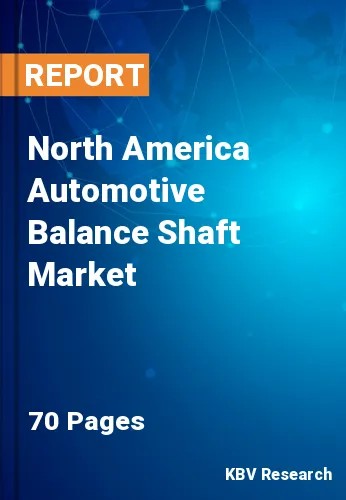The North America Automotive Balance Shaft Market would witness market growth of 3.6% CAGR during the forecast period (2021-2027).
The balancing shaft is a sophisticated component of an automobile that requires meticulous design. This is to ensure compatibility with the engines and their systems. The material used to make balancing shafts has a significant impact on the overall weight of the product. Aluminum balancing shafts are used by the majority of original equipment manufacturers (OEMs) for weight reduction and added strength. The second level of vibration is experienced by car engines, particularly those with asymmetric designs. The second level vibration is also experienced by well-balanced engines with asymmetric designs. The automobile balancing shaft is incorporated with the vehicle engines to counteract the engine's vibration effect. When compared to casted balance shafts, forged balance shafts are lighter compact, and have better inherent damping.
As autonomous and connected vehicles grow more common, handling data from vehicles is becoming an increasingly crucial part of ensuring safe and dependable transportation. Canada has the expertise to analyze the big data that connected vehicles are already producing. Canadian companies are collaborating with global OEMs to process massive volumes of data and optimize the performance of entire networks of vehicles, thanks to clusters of commercial and academic quantum computing R&D. Canadian businesses also have the know-how to keep that information safe. Substitute power train advancements are making sure that future automobiles will be greener and cleaner. Companies from throughout Canada are assisting in the development of these technologies. TM4's electric motors are powering heavy and light cars, due to Jeffrey Dahn's lithium-ion energy density research, which led to an exclusive research agreement with Tesla Motors. Hydrogen fuel cell research and development have created a cluster of local startups such as Hydrogenics and Ballard Power Systems, as well as attracting R&D investments from major OEMs.
The US market dominated the North America Automotive Balance Shaft Market by Country in 2020, and would continue to be a dominant market till 2027; thereby, achieving a market value of $2,535.7 Million by 2027. The Canada market is experiencing a CAGR of 6% during (2021 - 2027). Additionally, The Mexico market would showcase a CAGR of 5.1% during (2021 - 2027).
Based on Manufacturing Process, the market is segmented into Forging, and Casting. Based on Application, the market is segmented into Passenger Cars, Light Commercial Vehicles, and Heavy Commercial Vehicles. Based on Sales Channel, the market is segmented into Original Equipment Manufacturer, and Aftermarket. Based on Engine Type, the market is segmented into Inline 4-cylinder Engine, Inline 3-cylinder Engine, Inline 5-cylinder Engine, and V6 Engine. Based on countries, the market is segmented into U.S., Mexico, Canada, and Rest of North America.
Free Valuable Insights: The Global Automotive Balance Shaft Market is Estimated to reach $13.2 Billion by 2027, at a CAGR of 4.1%
The market research report covers the analysis of key stake holders of the market. Key companies profiled in the report include American Axle & Manufacturing, Inc., Engine Power Components, Inc., Hirschvogel Group, Linamar Corporation, MAT Foundry Group Ltd., Musashi Seimitsu Industry Co., Ltd., Ningbo Jingda Hardware Manufacture Co., Ltd., Otics Corporation, Sansera Engineering Limited, and TFO Corporation.
By Manufacturing Process
By Application
By Sales Channel
By Engine Type
By Country
Our team of dedicated experts can provide you with attractive expansion opportunities for your business.

